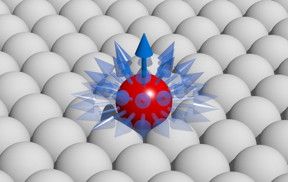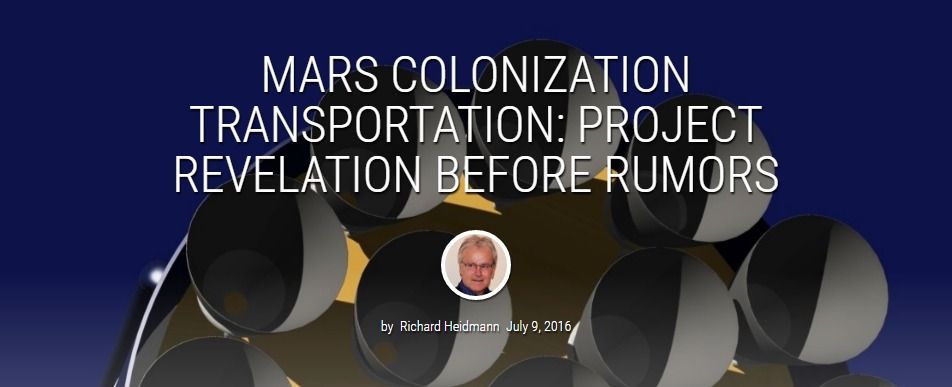Page 10991
Jul 11, 2016
Germs add ripples to make ‘groovy’ graphene
Posted by Karen Hurst in categories: biotech/medical, computing, engineering, nanotechnology, particle physics
Graphene, a two-dimensional wonder-material composed of a single layer of carbon atoms linked in a hexagonal chicken-wire pattern, has attracted intense interest for its phenomenal ability to conduct electricity. Now University of Illinois at Chicago researchers have used rod-shaped bacteria — precisely aligned in an electric field, then vacuum-shrunk under a graphene sheet — to introduce nanoscale ripples in the material, causing it to conduct electrons differently in perpendicular directions.
The resulting material, sort of a graphene nano-corduroy, can be applied to a silicon chip and may add to graphene’s almost limitless potential in electronics and nanotechnology. The finding is reported in the journal ACS Nano.
“The current across the graphene wrinkles is less than the current along them,” says Vikas Berry, associate professor and interim head of chemical engineering at UIC, who led the research.
Jul 11, 2016
Russia, China Agree On Long-Range, Widebody Airliner Partnership
Posted by Karen Hurst in category: transportation
The program will be managed by a specially formed company to be owned equally by the Chinese and Russian state manufacturers.
Jul 11, 2016
Russia Offers India Nuclear Aircraft Carrier
Posted by Karen Hurst in categories: futurism, military
NEW DELHI — Russia has offered its nuclear aircraft carrier, dubbed “Storm,” to India for purchase, a senior Indian Navy official said. The offer comes as India and the US discuss the transfer of technology for India’s future nuclear aircraft carrier, the INS Vishal.
A diplomat with the Russian Embassy confirmed that a Russian team visiting India last week made the offer.
Krylov State Research Center (KSRC), a Russian shipbuilding research and development institute, is designing the carrier, also known as Shtorm or Project 23000E.
Continue reading “Russia Offers India Nuclear Aircraft Carrier” »
Jul 11, 2016
Atomic bits despite zero-point energy? Jülich scientists explore novel ways of developing stable nanomagnets
Posted by Karen Hurst in categories: computing, mobile phones, nanotechnology, particle physics, quantum physics
Stable nanomagnets that ultimately improves data storage on the smallest of devices.
Abstract: So-called “zero-point energy” is a term familiar to some cinema lovers or series fans; in the fictional world of animated films such as “The Incredibles” or the TV series “Stargate Atlantis”, it denotes a powerful and virtually inexhaustible energy source. Whether it could ever be used as such is arguable. Scientists at Jülich have now found out that it plays an important role in the stability of nanomagnets. These are of great technical interest for the magnetic storage of data, but so far have never been sufficiently stable. Researchers are now pointing the way to making it possible to produce nanomagnets with low zero-point energy and thus a higher degree of stability (Nano Letters, DOI: 10.1021/acs.nanolett.6b01344).
Since the 1970s, the number of components in computer chips has doubled every one to two years, their size diminishing. This development has made the production of small, powerful computers such as smart phones possible for the first time. In the meantime, many components are only about as big as a virus and the miniaturization process has slowed down. This is because below approximately a nanometre, a billionth of a meter in size, quantum effects come into play. They make it harder, for example, to stabilise magnetic moments. Researchers worldwide are looking for suitable materials for magnetically stable nanomagnets so that data can be stored safely in the smallest of spaces.
I reported on this 3 weeks ago; however, here is a newer article on the quantum entanglement chaos. This article highlights Google’s involvement.
Researchers at UCSB blur the line between classical and quantum physics by connecting chaos and entanglement.
Jul 11, 2016
Manoj Saxena talks Artificial Intelligence with Gigaom
Posted by Karen Hurst in categories: finance, health, robotics/AI, security
Nice chime on QC.
Manoj Saxena is the executive chairman of CognitiveScale and a founding managing director of The Entrepreneurs’ Fund IV (TEF), a $100m seed fund focused exclusively on the cognitive computing space.
Saxena is also the chairman of Federal Reserve Bank of Dallas, San Antonio branch and Chairman, SparkCognition an Austin based cognitive security and safety analytics company.
Continue reading “Manoj Saxena talks Artificial Intelligence with Gigaom” »
Jul 11, 2016
A Sci-Fi Short Film: “THE SIGNAL”
Posted by Sean Brazell in categories: energy, entertainment, internet, media & arts

Enjoy this VFX Sci-Fi Short Film… 2046. A new energy source, created to solve the world’s energy crisis, is believed to have deadly side effects. When The Signal’s inventor chooses to help a girl warn the public, he gains an unlikely ally to save the world from his own creation. Starring Michael Ealy and Grace Phipps, Written and Directed by Marcus Stokes!
On the web — http://www.thesignalmovie.com
Jul 11, 2016
Mars Colonisation Transportation: Project Revelation Before Rumours
Posted by Michael Paton in categories: Elon Musk, government, space travel
Translated this intriguing article for English readers about our soon to occur Mars-Colonisation, and prospective announcements at the upcoming SpaceX Event!
In our analysis of end 2015 (available on our website, and its summary in the English section) we tried to discern what might look like the project SpaceX Mars Colonization Transportation (MCT), Elon Musk has finally unveiled Sept. 27 at the next International Astronautical Congress. This year included the meagre clues gleaned from the various statements of the contractor, some alter the previous information (eg abandonment of multi-body launcher formula type Falcon Heavy) or, coercion, seemed to confirm the fundamental options such as refuelling earth parking orbit by a second launcher, the total reuse and descent of March of the entire interplanetary shuttle ( “landing the whole thing”). Since then, other indications of various origins have appeared on fans forums. Examine their possible significance.
The choice single-body launcher recoverable and we had driven to approach the performance target (100 T Payload deposited on Mars) to increase the diameter of the drive bay 15 m, although it seemed sufficient to limit that of upstairs itself to 12.5m (pm the first two stages of the Saturn 5 moon had a diameter of 10 m). This configuration allowed to stay a maximum of 31 engines of 300 T thrust and achieve take-off weight (GLOW) 7750 T. Unfortunately, the shape flared rear of the first floor, certainly favourable to the stability phase of ascent, is very unfavourable for the return (flight in opposite direction), especially since it has less then effective ways to stabilise the trajectory. Since it is difficult to imagine that we can reduce the GLOW and therefore the take-off thrust, the solution is to increase the diameter of the whole floor to 15 m. Now it is one of the rumours on forums “MCT-geeks”; SpaceX had solicited tooling suppliers for this diameter.
Continue reading “Mars Colonisation Transportation: Project Revelation Before Rumours” »
Jul 11, 2016
‘Crowd Control,’ part 22: Spies in heaven
Posted by Zoltan Istvan in categories: cosmology, geopolitics, transhumanism
The final chapter in CNET’s historic “crowdsourced” sci-fi novel is out. You can read the whole thing here. Transhumanism is a large part of it (and a fictional version of my being President is in it too). This book was written by the participating public. This was a huge plus for the Transhumanist movement, as it meant transhumanism appeared many times on CNET as chapters were released (CNET is the world’s leading tech site in traffic):
In the finale of CNET’s historic crowdsourced sci-fi novel, the war on Earth is over, but the story of the multiverse may just be getting started.

















